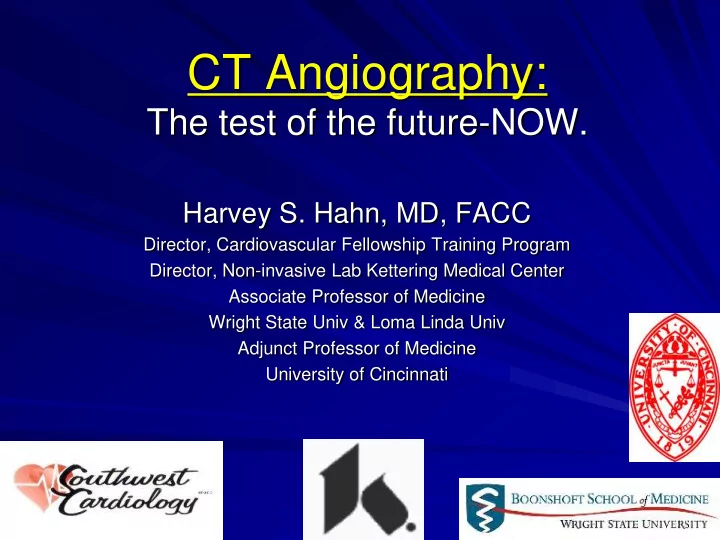

Why get a PET/CTA? Table 3. Proposed PET/CTA results clinical pathway CTA Findings PET Findings Probable Pathology Clinical Decision Normal Normal No epicardial CAD Risk factor modification Abnormal Normal Non-flow limiting CAD Medial therapy Normal Abnormal Small branch disease or pre- Medical therapy or cath clinical decrease in flow reserve if severe symptoms Abnormal Abnormal Flow limiting CAD Cath or medical therapy
Diagnostic strategies Hx is still critical first step for choosing strategy. Typical vs atypical CP. Degree of symptoms. Level of activity. Good CABG candidate or not. EF / viability.
The options are… 1-Straight exercise 6-Lexiscan-SPECT treadmill. 7-Dipyridamole-PET 2-Treadmill+echo (stress echo) 8-CTA 3-Stress-SPECT or 9-PET / CTA 4-Dobutamine echo or 5-Dobutamine-SPECT 10-Cath
PET PROS: More energy so better pictures, esp in obese pt. Attenuation correction. Increases the sensitivity and specificity beyond that of a SPECT scan. Get wall motion and EF at rest and stress. Faster than SPECT. Less radiation. We have a generator so doses not at the mercy of outside facilities. CONS: Coverage. Cannot do with exercise (yet).
Testing flow diagram Intermediate CP Can exercise CanNOT exercise 1. CTA EKG Normal 2. SPECT YES NO or female 3. PET 1.Stress Plain exercise 4. PET/CTA Stress test Echo 2.Stress- nuc 3. CTA Did this clarify things? Probably not. What question are you trying to answer? What are you going to do with the info / test results?
Money slide… Atypical CP -want to try and provoke symptoms- treadmill stress. Want to know if the pt has CAD or not . Don ’ t care about symptoms or ischemia- CTA . Low risk, don ’ t want to do anything unless you have to-want high specificity - stress echo . Want to avoid all radiation-stress echo. Don ’ t want to miss major problem- want high sensitivity- nuclear perfusion scan . Don ’ t want to miss anything- PET/CTA .
Summary No test is perfect, not even cath. Treadmill is always the best if possible. Especially for atypical CP. Echo and SPECT are similar as imaging modalities except in people with poor echo images. PET is the best. To rule out or rule in CAD, regardless of symptoms think CTA.
Stress Echo-dobutamine and exercise. Extremely safe. Thousands of pt studied. ~1/2000 adverse events. Safe within 2-3 days of MI. More specific, but not as sensitive for CAD as nuclear. Bax et al, JACC 1997
What else can you do to increase the yield of your tests ? Add an imaging modality on top of the treadmill. Nuc scans and echo both increase the Sens/spec/predictive values to ~85%. Additional imaging is especially helpful in females and pt with A picture is worth 1000 words ! abnl EKGs.
RESEARCH
Intro to Stats Sensitivity - Screen for disease. Specificity - Rule in for disease. Both Sens / Spec are inherent to the test itself. PPV - % results that are a true +. NPV - % results that are a true -. PPV / NPV depends on the population being tested.
The Rev. Bayes ’ Theorem
HIV in a nun… HIV ELIZA is 95% Disease sensitive and specific. + - Test How confident are + 95 tp 90 fp you of a + test in a - 5 fn 810 tn nun assuming a 10% dz prevalence? 100 900 total What is the likelihood of this being a true+? Sens=tp/(tp+fn) Spec=tn/(fp+tn) 51%! PPV=tp/(all positives) NPV=tn/(all neg)
Recommend
More recommend